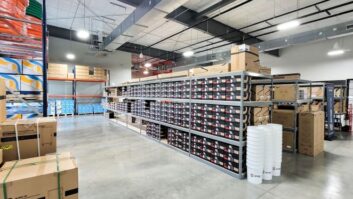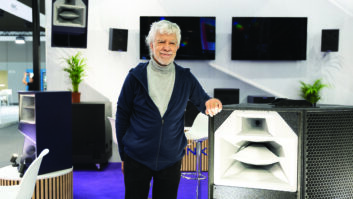 It’s safe to say people are glad to close the door on 2020. After a year of pandemic induced challenges, there is certainly a lot to be optimistic about. While the virus continues to rage around much of the western world as I write this at the end of 2020, effective vaccines are on the way, promising an eventual end to the worst of the disease-related outcomes. Sustained economic recovery can thus follow as in-person activity resumes to more normal levels. And with it, pro AV becomes an even more vibrant sector, bolstered by the heightened importance tech plays in experiences across the economy.
It’s safe to say people are glad to close the door on 2020. After a year of pandemic induced challenges, there is certainly a lot to be optimistic about. While the virus continues to rage around much of the western world as I write this at the end of 2020, effective vaccines are on the way, promising an eventual end to the worst of the disease-related outcomes. Sustained economic recovery can thus follow as in-person activity resumes to more normal levels. And with it, pro AV becomes an even more vibrant sector, bolstered by the heightened importance tech plays in experiences across the economy.
To put numbers to it, AVIXA estimates global revenues for pro AV solutions and products will grow by nearly 7% in 2021 after declining by at least 8% in 2020. The final analysis for the year may mean an even steeper decline for 2020 which translates to an even larger hole for the industry to climb out of in terms of the revenue difference from the peak year set in 2019. Right now, forecasted growth rates suggest pro AV doesn’t see real net growth over 2019 until 2022, but this will largely depend on the rate of recovery. Most economists think the first half of 2021 may be slow as vaccine uptake makes its way across the globe, but by the second half things are more meaningfully improving. As we look at the individual markets served by pro AV, some reason for optimism about upside potential emerge.
Hardest hit
Let’s start with the areas that were hardest hit by the pandemic – hospitality, venues, and retail. Each of these are the bastions of in-person experiences and so with health guidelines mandating limited crowd sizes and travel restrictions in effect, all three of these markets pulled way back on spending for pro AV in 2020. Revenues from hospitality clients were down 17% in 2020, 15% from venues, and 14% in retail with those estimates formulated in the middle of the year. Which means the actuals could be even worse.
And looking forward, some fret about whether these markets will ever fully
return to their past peaks if consumers demonstrate a lingering preference for the current normal of stay-at-home activity. Survey research doesn’t bear this fear out, however. Much of the concern over in-person activity is closely tied to the virus and vaccine availability continues to be viewed as the panacea by consumers who largely say they are willing to go back once widespread deployment is achieved. This fuels a strong forecast for the declining industries as a result. AVIXA forecasts 12% growth in hospitality, 10% in venues and 10% in retail spending for pro AV.
Perhaps even better news for the sector, these growth estimates may prove to be conservative. Why? The fundamental role technology plays in each is changing and expanding. Take hospitality as an example. Our post-pandemic normal is likely to continue to include an increased number of video-conferencing calls as we log-in to more virtual meetings and events. This places an increased burden on the infrastructure within a hotel property as guests expect more reliable network connections and perhaps room set-ups that are more conducive to our new mode of collaboration. Conference facilities on property must also adapt to the hybridization that event attendees will expect. Venues face the same.
Retail too will feel the pressure to adapt to more mixed mode shopping among consumers who want to blend the best of the in-person and online shopping experiences. In all cases, forecasts largely predict the return of the previous rates of investments in technology across the verticals, and don’t typically account for innovation or acceleration of usage. One could argue tech’s importance to each has accelerated due to change in our perceived normal way of engaging in activity.
Strongest growth
This shift becomes more apparent as we look at the solution areas predicted to see the strongest growth during the recovery period. These solutions also nicely align with the markets above and are the ones most impacted by declines in those markets. Live events are the most widely discussed here, which in best case saw revenues declines of 22% globally in 2020. Any remaining revenue likely came from support for the shift to online events and support for content capture and distribution, blurring it with the other solution area of that name.
Fixed performance and entertainment solutions were similarly hit, declining 16% as venues ceased investing. Lastly, digital signage revenues pulled back by 11% as retail and hospitality put projects on ice.
Looking ahead, all three solution types see good growth as their related markets recover, even if true growth over previous peaks remains further in the future. AVIXA forecasts pro AV revenues from live events to grow 10% in 2021. Digital signage also recovers at a healthy clip, realising over 7% growth. Of the three, only performance/entertainment remains slow to an expected hesitance to reinvest in these solutions, which include cinemas, as the related markets wait for revenues from consumers to return first.
Safe solutions
The sweet spot for solutions though, and the area expected to realise the most growth, is a bit less traditional for pro AV, though it is related to those above and is clearly front and center in a health crisis – security, surveillance, and life safety. Solutions here include both public address systems, video monitoring, fire alarm, and many other technologies. They now even include foot traffic and symptom monitoring checkpoints which are blending into digital signage installations being used in transportation, education, venues, and corporate settings.
As one might imagine, all of these are viewed as important areas of investment as businesses strive to continue activities in safe ways in accordance to health guidelines during the pandemic. This translates not only to a bolstered result for 2020, but for heightened investment in the period of recovery. Last year, revenues from life safety solutions declined by only a single percent and 2021 shows the potential for 15% growth.
This continues even into 2022, which rises another 12%. The successive years of rapid expansion makes this solution area a top growth prospect for the forecast period running from 2020 to 2025, with an expected 9% compound annual growth rate (CAGR). The point? If you aren’t engaged in these solutions in some way yet, you either will be or should be.
There is more to the story of opportunity yet to tell though. Notice I said life safety is A top area of growth and not THE top area? That distinction goes to a strange one, in that it is normally just a catch basin for the left-over activity. It’s the proverbial ‘Other’ category. Usually this is an afterthought in a forecaster’s modelling efforts and is where anything not represented by the defined list of solutions would go. As a result, it is often just assigned a modicum of growth to balance out the forecast. In this case, AVIXA and its partner Omdia, have purposefully assigned the other solutions the highest expected CAGR at nearly 10%. The reason for this is quite simple – we expect innovation from solutions not fitting the mold of the defined set to see the most significant expansion.
Think about that for a moment. While known areas will recover and expand post-pandemic, it’s those things we don’t have defined and are completely new that will represent the next phase of expansion for pro AV. This should inspire those in the market that there are new areas ripe for both the defining and the taking, even as it challenges our previous notions of what constitutes a solution in our market. As we enter this new era of a better normal, here’s wishing you all many successes as you go out and find that new frontier.







